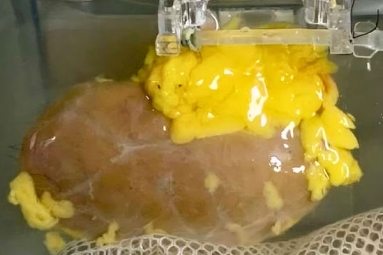
Pesticides based on fungi are just one example of the biopesticides, a group that also includes the bacteria and biochemicals derived from plants.
Biopesticides are only a tiny segment of the market for now, but their use is projected to grow at a faster pace than traditional synthetic pesticides over the next few years. The growth of the organic produce industry is one of the factor giving biopesticides a boost. So, too, are regulatory hurdles, said Sara Olson, a senior analyst at the Lux Research.
And then there is the rise of weeds and also microbes resistant to traditional pesticides.
Some of the biopesticides repel pests, while some others disrupt mating or cause a specific disease to strike the invaders that would nibble on delicate fruits and vegetables.
The fungal-based biopesticides take things up a notch. Many of these products contain the parasitic fungi, a kind of fungi that grow inside an insect's body and feed on its internal tissue until it dies (and sometimes it may be beyond that).

While this may sound horrific, for some of the benefits using fungal-based biopesticides, rather than using the traditional chemicals, may outweigh the brutality.
A professor at the University of Florida Institute of Food and Agricultural Sciences, Nemat Keyhani said fungus is compatible with organic farming, harmless to the vertebrates just like humans, birds, dogs and cattle and also has a low environmental impact.
That is especially true when compared with the synthetic pesticides, which often contain the toxic chemicals such as arsenic, chlorine, ammonia and also formaldehyde. Some of the synthetic pesticides have been shown to have harmful effects on the environment and also human health. One family of the pesticides, called neonicotinoids, is being blamed for the decline in the bee populations over the last decade.

On the other hand, fungi are alive, and they could evolve along with the insects that they are being used to control. That means the pesticide resistance may become less of an issue, said Olson.
There are approximately 1,000 known species of the entomopathogenic fungi, the kind which kill or seriously disable insects. Collectively they target most or if not all, agricultural pests, said Raymond St. Leger, an entomologist at the University of Maryland.
When it comes to the biopesticides, one of the most widely used fungi is Beauveria bassiana. It infects a range of the insects and is commercially formulated as the products including Naturalis L, Naturalis H&G, Mycotrol and BotaniGard.
"In the 1800s, this was one of the very first fungi recognized as a disease agent that killed insects," said St. Leger.
The fungi causes a disease known as the white muscardine. Even after the insect is killed, the downy mold continues to produce millions of new infective spores which are released into the environment. Beauveria bassiana effectively targets the pecan weevil, Colorado potato beetle and also kudzu bug, among the other pests.

Trichoderma, which is a versatile mold, is also commonly used. Some release enzymes which dissolve potential pathogens, others form barriers around the plant roots and make it impossible for the harmful bacteria and pathogens to pass through.
Another fungus called Metarhizium or the green muscardine fungus, is frequently used in the field, for shielding crops from beetle grubs, wireworm, corn root worms and also countless other insects. One variant is now being used to develop the biopesticides, including a line by the MycoPesticide, which can cause a mushroom to grow from a pest's dead body to distribute spores that will warn other insects.
But biopesticides can be quite expensive compared to the synthetic pesticides. They often do not work as quickly and also they have to be applied more frequently, making them a tough sell in the markets.
Paul Underhill, co-owner of the Terra Firma Farm, an organic grower in the Winters, Calif., has tried a few of these. "Some, like those with fungi, can require special storage, such as refrigeration. [And] the cost to the farmer can easily be 20 times what a conventional pesticide might be," he says.

One more downside is that, biopesticides can be more sensitive to the environmental conditions, including relative humidity, temperature and also exposure to UV radiation.
Genetic manipulation might be the next step to get more number of fungi-based products to the market. Scientists are working with the transgenic strains to improve fungi's ability to kill the insects, tolerate to adverse conditions and, extending beyond the crops, fight against the transmission of diseases such as the West Nile virus, Lyme disease and also malaria. St. Leger's team is currently testing a strain of the Metarhizium which had a spider gene inserted and selectively targets mosquitoes.
Mrudula Duddempudi.










